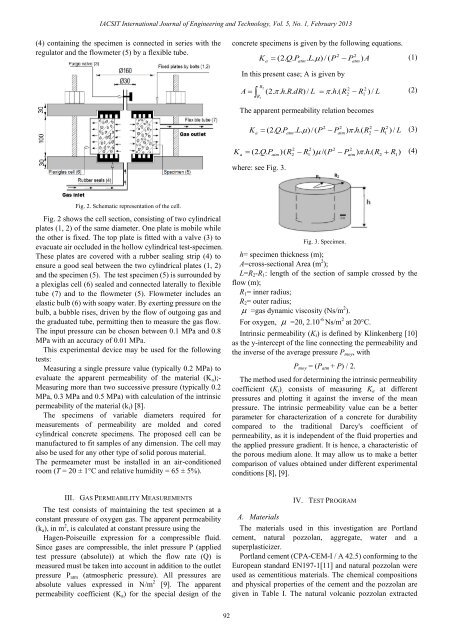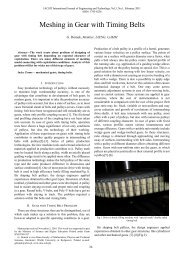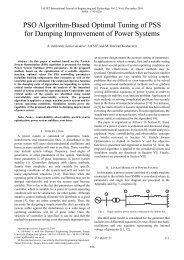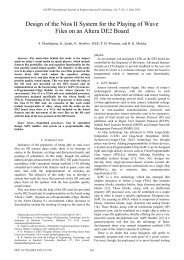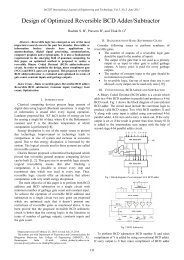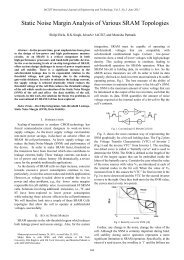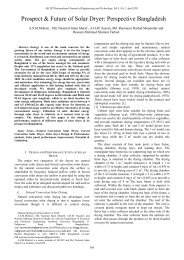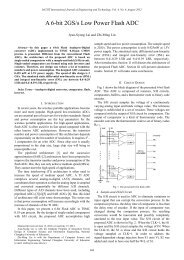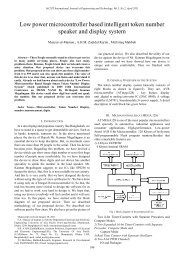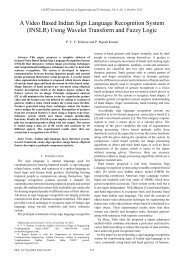A Modified Test Procedure to Measure Gas Permeability of ... - IJET
A Modified Test Procedure to Measure Gas Permeability of ... - IJET
A Modified Test Procedure to Measure Gas Permeability of ... - IJET
Create successful ePaper yourself
Turn your PDF publications into a flip-book with our unique Google optimized e-Paper software.
IACSIT International Journal <strong>of</strong> Engineering and Technology, Vol. 5, No. 1, February 2013<br />
(4) containing the specimen is connected in series with the<br />
regula<strong>to</strong>r and the flowmeter (5) by a flexible tube.<br />
concrete specimens is given by the following equations.<br />
K<br />
2<br />
(2. Q.<br />
P . L.<br />
)/( P<br />
2 P A<br />
(1)<br />
a atm<br />
atm)<br />
In this present case; A is given by<br />
A <br />
R2<br />
R1<br />
2 2<br />
(2. . h.<br />
R.<br />
dR) / L .<br />
h.(<br />
R R ) / L (2)<br />
The apparent permeability relation becomes<br />
2 2<br />
2 2<br />
Ka (2. Q.<br />
Patm<br />
. L.<br />
)/( P Patm<br />
) .<br />
h.(<br />
R2<br />
R1<br />
)/<br />
L (3)<br />
2<br />
1<br />
K<br />
a<br />
2 2 2 2<br />
( 2. Q.<br />
Patm<br />
)( R2 R1<br />
) /( P Patm<br />
) .<br />
h.(<br />
R2<br />
R1<br />
) (4)<br />
where: see Fig. 3.<br />
Fig. 2. Schematic representation <strong>of</strong> the cell.<br />
Fig. 2 shows the cell section, consisting <strong>of</strong> two cylindrical<br />
plates (1, 2) <strong>of</strong> the same diameter. One plate is mobile while<br />
the other is fixed. The <strong>to</strong>p plate is fitted with a valve (3) <strong>to</strong><br />
evacuate air occluded in the hollow cylindrical test-specimen.<br />
These plates are covered with a rubber sealing strip (4) <strong>to</strong><br />
ensure a good seal between the two cylindrical plates (1, 2)<br />
and the specimen (5). The test specimen (5) is surrounded by<br />
a plexiglas cell (6) sealed and connected laterally <strong>to</strong> flexible<br />
tube (7) and <strong>to</strong> the flowmeter (5). Flowmeter includes an<br />
elastic bulb (6) with soapy water. By exerting pressure on the<br />
bulb, a bubble rises, driven by the flow <strong>of</strong> outgoing gas and<br />
the graduated tube, permitting then <strong>to</strong> measure the gas flow.<br />
The input pressure can be chosen between 0.1 MPa and 0.8<br />
MPa with an accuracy <strong>of</strong> 0.01 MPa.<br />
This experimental device may be used for the following<br />
tests:<br />
Measuring a single pressure value (typically 0.2 MPa) <strong>to</strong><br />
evaluate the apparent permeability <strong>of</strong> the material (K a );-<br />
Measuring more than two successive pressure (typically 0.2<br />
MPa, 0.3 MPa and 0.5 MPa) with calculation <strong>of</strong> the intrinsic<br />
permeability <strong>of</strong> the material (k i ) [8].<br />
The specimens <strong>of</strong> variable diameters required for<br />
measurements <strong>of</strong> permeability are molded and cored<br />
cylindrical concrete specimens. The proposed cell can be<br />
manufactured <strong>to</strong> fit samples <strong>of</strong> any dimension. The cell may<br />
also be used for any other type <strong>of</strong> solid porous material.<br />
The permeameter must be installed in an air-conditioned<br />
room (T = 20 ± 1°C and relative humidity = 65 ± 5%).<br />
Fig. 3. Specimen.<br />
h= specimen thickness (m);<br />
A=cross-sectional Area (m 2 );<br />
L=R 2 -R 1 : length <strong>of</strong> the section <strong>of</strong> sample crossed by the<br />
flow (m);<br />
R 1 = inner radius;<br />
R 2 = outer radius;<br />
=gas dynamic viscosity (Ns/m 2 ).<br />
For oxygen, =20, 2.10 -6 Ns/m 2 at 20°C.<br />
Intrinsic permeability (K i ) is defined by Klinkenberg [10]<br />
as the y-intercept <strong>of</strong> the line connecting the permeability and<br />
the inverse <strong>of</strong> the average pressure P moy , with<br />
P moy = (P atm + P) / 2.<br />
The method used for determining the intrinsic permeability<br />
coefficient (K i ) , consists <strong>of</strong> measuring K a at different<br />
pressures and plotting it against the inverse <strong>of</strong> the mean<br />
pressure. The intrinsic permeability value can be a better<br />
parameter for characterization <strong>of</strong> a concrete for durability<br />
compared <strong>to</strong> the traditional Darcy's coefficient <strong>of</strong><br />
permeability, as it is independent <strong>of</strong> the fluid properties and<br />
the applied pressure gradient. It is hence, a characteristic <strong>of</strong><br />
the porous medium alone. It may allow us <strong>to</strong> make a better<br />
comparison <strong>of</strong> values obtained under different experimental<br />
conditions [8], [9].<br />
III. GAS PERMEABILITY MEASUREMENTS<br />
The test consists <strong>of</strong> maintaining the test specimen at a<br />
constant pressure <strong>of</strong> oxygen gas. The apparent permeability<br />
(k a ), in m 2 , is calculated at constant pressure using the<br />
Hagen-Poiseuille expression for a compressible fluid.<br />
Since gases are compressible, the inlet pressure P (applied<br />
test pressure (absolute)) at which the flow rate (Q) is<br />
measured must be taken in<strong>to</strong> account in addition <strong>to</strong> the outlet<br />
pressure P atm (atmospheric pressure). All pressures are<br />
absolute values expressed in N/m 2 [9]. The apparent<br />
permeability coefficient (K a ) for the special design <strong>of</strong> the<br />
A. Materials<br />
IV. TEST PROGRAM<br />
The materials used in this investigation are Portland<br />
cement, natural pozzolan, aggregate, water and a<br />
superplasticizer.<br />
Portland cement (CPA-CEM-I / A 42.5) conforming <strong>to</strong> the<br />
European standard EN197-1[11] and natural pozzolan were<br />
used as cementitious materials. The chemical compositions<br />
and physical properties <strong>of</strong> the cement and the pozzolan are<br />
given in Table I. The natural volcanic pozzolan extracted<br />
92


